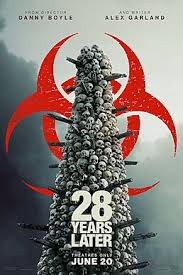.
28 Years Later, the second sequel to pandemic/zombie movie 28 Days Later picks up where the title implies, 28 years after due to well-meaning but idiotic animal rights activists caused the release of the ‘rage virus’ the islands of the United Kingdom are under a strictly enforced quarantine populated by the infected and survivors attempting to scratch out life and community on the British island.
28 Years Later is centered on a small nuclear family, 12-year-old Spike (Alfie Williams), his father Jamie (Aaron Taylor-Johnson) and his clearly ill mother Isla (Jodie Comer). Jamie takes Spike across a causeway that keeps the island community safe from the infected for an initiation into what life on the mainland, infested with the infected, is like. The trip into the mainland alerts Spike to that his father is not entirely honest and that a man considered dangerously insane living there is in fact a physician. Desperate to save Isla Spike takes his mother to the mainland on a perilous quest to find the doctor.
Written by Alex Garland and directed by Danny Boyle, the team that created the original film, 28 Years Later is a very competently crafted piece of cinema. Cinematographer Anthony Dod Mantle handled the assignment of using handheld unsteady quite well producing the emotionally disjointed sensations without overusing the technique to the point of motion sickness. (At least for this viewer.)
That said, I never emotionally engaged with this movie. The first act, Spike and Jaime’s expedition to the mainland felt more like the introductory level of a video game that established the world and its rules and less like the opening act of compelling story. The father/son interactions are not enough to pull me fully into caring about either of them. Isla’s illness, while tragic, feels more like external motivation. The fact that she has good moments and bad moments mentally, but we don’t really, for the most part, see who she was before the illness took over her life, presents Isla as more of a hypothetical character than a fully realized one.
Without being drawn into a story that compels my attention emotionally I was left with time for my mind to wander which only exposed elements of the world building I found unresolvable.
The ‘Infected’ present the same narrative issues as the ‘reavers’ did in 2005’s Firefly sequel film Serentiy. I simply cannot picture how they function when they are not on the screen chasing down and killing the non-infected. In the original film it was presented that the virus, acting far too quickly for any actual infection, activated the emotion of violent rage in its victims. Rational thought vanished and whenever an infected person noticed an uninfected one, they chased them down with murderous intent. That’s all fine and dandy but after a few weeks there will not be any more active infected. If you are not maintaining yourself, food and water, you will die.
Okay, so maybe, just maybe, the infected possess enough of their faculties take care of such matters. 30 years later there should be no infected. In the course of this film, we witness an infected woman giving birth. That means that there has to be sexual relations between the infected, not a product of the emotion of rage. For there to be generations of infected that means the infected must be raising children and the raising of human children is a labor and cognitively intensive task. I simply found it impossible to suspend my disbelief for the basic core concept of the movie.
Others feel differently. 28 Years Later is being hailed among the horror community as a great film and you may find it so, I, however, while not repelled by it found it less than interesting.


Considering the movements the infected make I wonder how they can live years without a chiropractor. They must be magic zombies since none appear to be injured. However, I have not seen the other movies, so don’t know what they have shown.